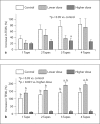Sun-induced changes in stratum corneum function are gender and dose dependent in a Chinese population
- PMID: 20571289
- PMCID: PMC2968765
- DOI: 10.1159/000314138
Sun-induced changes in stratum corneum function are gender and dose dependent in a Chinese population
Abstract
Previous studies have demonstrated that UVB radiation changes the epidermal permeability barrier and stratum corneum (SC) hydration. It is well known that sun exposure causes erythema, sunburn and melanoma. However, whether daily sun exposure alters SC integrity and epidermal permeability barrier function is largely unknown, especially in Chinese subjects. In the present study, we assess the SC integrity, SC hydration and epidermal permeability barrier function following various doses of sun exposure. A total of 258 subjects (124 males and 134 females) aged 18-50 years were enrolled. A multifunctional skin physiology monitor (Courage & Khazaka MPA5) was used to measure SC hydration and transepidermal water loss (TEWL) on the forearms. In males, basal TEWL was higher with higher doses of sun exposure than with lower doses and control, whereas in females, basal TEWL was higher with lower doses of sun exposure than with higher doses and control. In the group with higher doses of sun exposure, TEWL in females was significantly lower than that in males. The barrier recovery was faster in females than in males in both control and lower-dose groups. In both males and females, barrier recovery was delayed with higher doses of sun exposure. In males, sun exposure did not alter SC hydration, while in females SC hydration was lower with lower doses of sun exposure as compared with control and higher doses of sun exposure. These results demonstrated that sun-induced changes in SC function and SC hydration vary with gender and the extent of sun exposure.
Copyright 2010 S. Karger AG, Basel.
Figures




Similar articles
-
Sun-induced changes of stratum corneum hydration vary with age and gender in a normal Chinese population.Skin Res Technol. 2012 Feb;18(1):22-8. doi: 10.1111/j.1600-0846.2011.00536.x. Epub 2011 Apr 20. Skin Res Technol. 2012. PMID: 21507068
-
Validation of GPSkin Barrier® for assessing epidermal permeability barrier function and stratum corneum hydration in humans.Skin Res Technol. 2019 Jan;25(1):25-29. doi: 10.1111/srt.12590. Epub 2018 Jun 4. Skin Res Technol. 2019. PMID: 29863296
-
Epidermal permeability barrier recovery is delayed in vitiligo-involved sites.Skin Pharmacol Physiol. 2010;23(4):193-200. doi: 10.1159/000288166. Epub 2010 Feb 25. Skin Pharmacol Physiol. 2010. PMID: 20185976 Free PMC article.
-
Could tight junctions regulate the barrier function of the aged skin?J Dermatol Sci. 2016 Mar;81(3):147-52. doi: 10.1016/j.jdermsci.2015.11.009. Epub 2015 Nov 28. J Dermatol Sci. 2016. PMID: 26639794 Review.
-
Skin hydration: a review on its molecular mechanisms.J Cosmet Dermatol. 2007 Jun;6(2):75-82. doi: 10.1111/j.1473-2165.2007.00300.x. J Cosmet Dermatol. 2007. PMID: 17524122 Review.
Cited by
-
Heavy Cigarette Smokers in a Chinese Population Display a Compromised Permeability Barrier.Biomed Res Int. 2016;2016:9704598. doi: 10.1155/2016/9704598. Epub 2016 Jun 29. Biomed Res Int. 2016. PMID: 27437403 Free PMC article.
-
Sex differences in skin carotenoid deposition and acute UVB-induced skin damage in SKH-1 hairless mice after consumption of tangerine tomatoes.Mol Nutr Food Res. 2015 Dec;59(12):2491-501. doi: 10.1002/mnfr.201500317. Epub 2015 Oct 20. Mol Nutr Food Res. 2015. PMID: 26394800 Free PMC article.
-
The Association between the Level of Advanced Glycation End Products and Objective Skin Quality Parameters.Life (Basel). 2023 Jan 17;13(2):256. doi: 10.3390/life13020256. Life (Basel). 2023. PMID: 36836618 Free PMC article.
-
Characterization of Epidermal Function in Individuals with Primary Cutaneous Amyloidosis.Clin Cosmet Investig Dermatol. 2023 Nov 6;16:3193-3200. doi: 10.2147/CCID.S426209. eCollection 2023. Clin Cosmet Investig Dermatol. 2023. PMID: 37953856 Free PMC article.
-
Gender-Related Characterization of Acne in Chinese: A Multiple-Center Cross-Sectional Survey on 13085 Cases.Clin Cosmet Investig Dermatol. 2024 Dec 20;17:3013-3021. doi: 10.2147/CCID.S484957. eCollection 2024. Clin Cosmet Investig Dermatol. 2024. PMID: 39720093 Free PMC article.
References
-
- Yarak S, Ogawa MM, Hirata S, de Almeida FA. Prevalence of acquired melanocytic naevi in Brazilian schoolchildren. Clin Exp Dermatol. 2009 E-pub ahead of print. - PubMed
-
- Naldi L, Altieri A, Imberti GL, Gallus S, Bosetti C, La Vecchia C, Oncology Study Group of the Italian Group for Epidemiologic Research in Dermatology Sun exposure, phenotypic characteristics, and cutaneous malignant melanoma: an analysis according to different clinico-pathological variants and anatomic locations (Italy) Cancer Causes Control. 2005;16:893–899. - PubMed
-
- Crijns MB, Klaver C, de Boer A, Van Hees C, Vermeer BJ, Vandenbroucke J, Bergman W. Ultraviolet exposure and the development of banal and atypical naevi – a cross-sectional study on Curaçao and in the Netherlands. Melanoma Res. 1997;7:407–416. - PubMed
-
- Harrison SL, MacLennan R, Buettner PG. Sun exposure and the incidence of melanocytic nevi in young Australian children. Cancer Epidemiol Biomarkers Prev. 2008;17:2318–2324. - PubMed
-
- Dulon M, Weichenthal M, Blettner M, Breitbart M, Hetzer M, Greinert R, Baumgardt-Elms C, Breitbart EW. Sun exposure and number of nevi in 5- to 6-year-old European children. J Clin Epidemiol. 2002;55:1075–1081. - PubMed
Publication types
MeSH terms
Grants and funding
LinkOut - more resources
Full Text Sources

